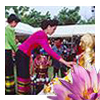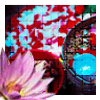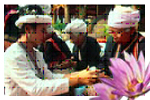Get To Know Songkran Custom!
 1. Songkran is the traditional Thai New Year. The festival offers not 1. Songkran is the traditional Thai New Year. The festival offers not  only the fun water throwing but also other interesting activities such as merits making and house cleaning, considered a way to help protect the environment. only the fun water throwing but also other interesting activities such as merits making and house cleaning, considered a way to help protect the environment.
 2. The purpose of bathing or splashing water in the Songkran Festival is to give and request for blessings through water, not for the rigorous water war. 2. The purpose of bathing or splashing water in the Songkran Festival is to give and request for blessings through water, not for the rigorous water war.
 3. Applying soft chalk powder called "Din Saw Phong" on one’s face or body is traditionally an individual’s choice of dressing and, thus, a personal business. You should not offer unsolicited help with it. To touch others without their permission is considered an ill manner by civilised Thais. 3. Applying soft chalk powder called "Din Saw Phong" on one’s face or body is traditionally an individual’s choice of dressing and, thus, a personal business. You should not offer unsolicited help with it. To touch others without their permission is considered an ill manner by civilised Thais.
  4. The proper bathing is divided into two categories: 4. The proper bathing is divided into two categories:
- The bathing rite for the elders (aged over 60 years old, according to the old custom) as a tribute of respect and for blessings. As a youngster, you can pour scented water onto the hands of the elders without pronouncing any blessings. The elders in return will bestow their best wishes upon you.
- The bathing rite for the peers or juniors. You should ask for permission before gently pouring the scented water over the person’s shoulder and down his/her back and uttering words of blessing for the New Year. However, if you are close friends, you can enjoy splashing water on each other as you wish yet with appropriate manners and moral and safety cautions.
 5. The water used for bathing and splashing is regarded as sacred. Thus, it must be clean water, "Nam Ob" (water saturated with perfumes, either of Thai or Western origin) or scented water with floral pedals, and NOT dirty water or ice. 5. The water used for bathing and splashing is regarded as sacred. Thus, it must be clean water, "Nam Ob" (water saturated with perfumes, either of Thai or Western origin) or scented water with floral pedals, and NOT dirty water or ice.
 6. Traditionally, upon the bathing ritual, the elders are presented with toilet items, namely clothes, “Pha-hom”, “Pha-nung” (loin cloth), handkerchiefs, towels, soap, perfumes and powder. However, not every aforementioned article is required. You can prepare the toilet gift set as you see fit and may or may not add other presents such as flowers and sweet. 6. Traditionally, upon the bathing ritual, the elders are presented with toilet items, namely clothes, “Pha-hom”, “Pha-nung” (loin cloth), handkerchiefs, towels, soap, perfumes and powder. However, not every aforementioned article is required. You can prepare the toilet gift set as you see fit and may or may not add other presents such as flowers and sweet.
 7. Making obeisance is the highest form of respect by prostrating oneself with palms pressed together and then bowing until the pressed palms, arms and forehead touch the floor in front of the person or the image one pays respect to. The palms must be kept pressed together and separated when making obeisance to the Buddha image or monks only. 7. Making obeisance is the highest form of respect by prostrating oneself with palms pressed together and then bowing until the pressed palms, arms and forehead touch the floor in front of the person or the image one pays respect to. The palms must be kept pressed together and separated when making obeisance to the Buddha image or monks only.

 8. To bathe the Buddha image or any idol, it is more appropriate to pour the scented water on other parts of the Buddha image than on its head. 8. To bathe the Buddha image or any idol, it is more appropriate to pour the scented water on other parts of the Buddha image than on its head.
 9. “Rod Nam Dum Hua” or paying respect through the pouring of Songkran water is the northern Old Lanna custom. The ceremony is different from those in other parts of Thailand in some details. 9. “Rod Nam Dum Hua” or paying respect through the pouring of Songkran water is the northern Old Lanna custom. The ceremony is different from those in other parts of Thailand in some details.
The term ‘Dum Hua’ is dialectal and may present a wrong meaning if employed for the Songkran ceremonies elsewhere in the country.
 10. Songkran is the custom of all Thai people regardless of religions. Those who are not Buddhists can make merits on this occasion based on their religions and beliefs and also enjoy other activities of the Festival. 10. Songkran is the custom of all Thai people regardless of religions. Those who are not Buddhists can make merits on this occasion based on their religions and beliefs and also enjoy other activities of the Festival.
 11. The Songkran festival is held only once a year. We would like to invite all Thai people to come out and celebrate the festival in Thai traditional costume to preserve our glorious culture. Besides, our costume is cool! 11. The Songkran festival is held only once a year. We would like to invite all Thai people to come out and celebrate the festival in Thai traditional costume to preserve our glorious culture. Besides, our costume is cool!
|
 TOURISM UPDATE
TOURISM UPDATE